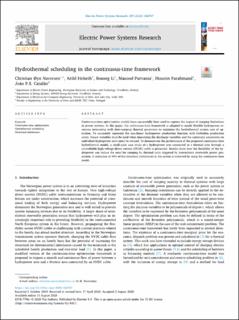| dc.contributor.author | Naversen, Christian Øyn | |
| dc.contributor.author | Helseth, Arild | |
| dc.contributor.author | Li, Bosong | |
| dc.contributor.author | Parvania, Masood | |
| dc.contributor.author | Farahmand, Hossein | |
| dc.contributor.author | Catalao, João P.S. | |
| dc.date.accessioned | 2020-10-14T09:02:56Z | |
| dc.date.available | 2020-10-14T09:02:56Z | |
| dc.date.created | 2020-08-19T11:52:49Z | |
| dc.date.issued | 2020 | |
| dc.identifier.issn | 0378-7796 | |
| dc.identifier.uri | https://hdl.handle.net/11250/2682670 | |
| dc.description.abstract | Continuous-time optimization models have successfully been used to capture the impact of ramping limitations in power systems. In this paper, the continuous-time framework is adapted to model flexible hydropower resources interacting with slow-ramping thermal generators to minimize the hydrothermal system cost of operation. To accurately represent the non-linear hydropower production function with forbidden production zones, binary variables must be used when linearizing the discharge variables and the continuity constraints on individual hydropower units must be relaxed. To demonstrate the performance of the proposed continuous-time hydrothermal model, a small-scale case study of a hydropower area connected to a thermal area through a controllable high-voltage direct current (HVDC) cable is presented. Results show how the flexibility of the hydropower can reduce the need for ramping by thermal units triggered by intermittent renewable power generation. A reduction of 34% of the structural imbalances in the system is achieved by using the continuous-time model. © 2020 The Authors | en_US |
| dc.language.iso | eng | en_US |
| dc.publisher | Elsevier | en_US |
| dc.rights | Navngivelse 4.0 Internasjonal | * |
| dc.rights.uri | http://creativecommons.org/licenses/by/4.0/deed.no | * |
| dc.title | Hydrothermal scheduling in the continuous-time framework | en_US |
| dc.type | Peer reviewed | en_US |
| dc.type | Journal article | en_US |
| dc.description.version | publishedVersion | en_US |
| dc.rights.holder | The Authors | en_US |
| dc.source.pagenumber | 106787 | en_US |
| dc.source.volume | 189 | en_US |
| dc.source.journal | Electric power systems research | en_US |
| dc.identifier.doi | https://doi.org/10.1016/j.epsr.2020.106787 | |
| dc.identifier.cristin | 1824010 | |
| dc.relation.project | Norges forskningsråd: 268014 | en_US |
| cristin.ispublished | true | |
| cristin.fulltext | original | |
| cristin.qualitycode | 1 | |

